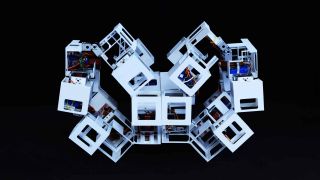Origami-inspired 'transformer' robots could help build habitats in space (photo)
These configurable bots could launch flat and then be assembled in space.

A newly designed "transformer" robot with the ability to change shape could one day be used to build habitats in space.
Engineers from North Carolina State University (NC State) have created a plastic cubed structure that can transform into more than 1,000 configurations using only three active motors. In theory, their design — which was largely inspired by the paper-folding art of origami — offers a more efficient way to send assembly structures into space, where the robot could then "transform" to serve various purposes, including carrying a load, according to an NC State statement.
"We think these can be used as deployable, configurable space robots and habitats," Antonio Di Lallo, co-first author of the study and an NC State postdoctoral researcher, said in the statement. "It's modular, so you can send it to space flat and assemble it as a shelter or as a habitat, and then disassemble it."
The team's transformer bots consist of 36 3D-printed hollow, plastic cubes assembled with rotating hinges. Some of the hinges are fixed with metal pins, while others are activated wirelessly with a motor. The researchers were able to transform the robotic structures into various shapes, ranging from tunnels and bridges to multi-story architectures.
"The question we're asking is how to achieve a number of versatile shapes with the fewest number of actuators powering the shapeshifting," Jie Yin, co-author of the study and associate professor of mechanical and aerospace engineering at NC State, said in the same statement. "Here we use a hierarchical concept observed in nature — like layered muscle fibers — but with plastic cubes to create a transforming robot."
Related: Could these big expandable habitats help humanity settle the moon and Mars?
In the process of changing shape, the transformer bots are able to move forward, backward and sideways. The bots can transform relatively quickly from flat, or fully open, to a box-like larger cube, or fully closed structure. They can also carry a load about three times their own weight and travel up an inclined surface, according to the statement.
Get the Space.com Newsletter
Breaking space news, the latest updates on rocket launches, skywatching events and more!
"We want to make a more robust structure that can bear larger loads," Yanbin Li, co-author of the study and an NC State postdoctoral researcher, said in the statement. "If we want a car shape, for example, how do we design the first structure that can transform into a car shape? We also want to test our structures with real-world applications like space robots."
Their findings were published July 26 in the journal Nature Communications.
Join our Space Forums to keep talking space on the latest missions, night sky and more! And if you have a news tip, correction or comment, let us know at: community@space.com.

Samantha Mathewson joined Space.com as an intern in the summer of 2016. She received a B.A. in Journalism and Environmental Science at the University of New Haven, in Connecticut. Previously, her work has been published in Nature World News. When not writing or reading about science, Samantha enjoys traveling to new places and taking photos! You can follow her on Twitter @Sam_Ashley13.